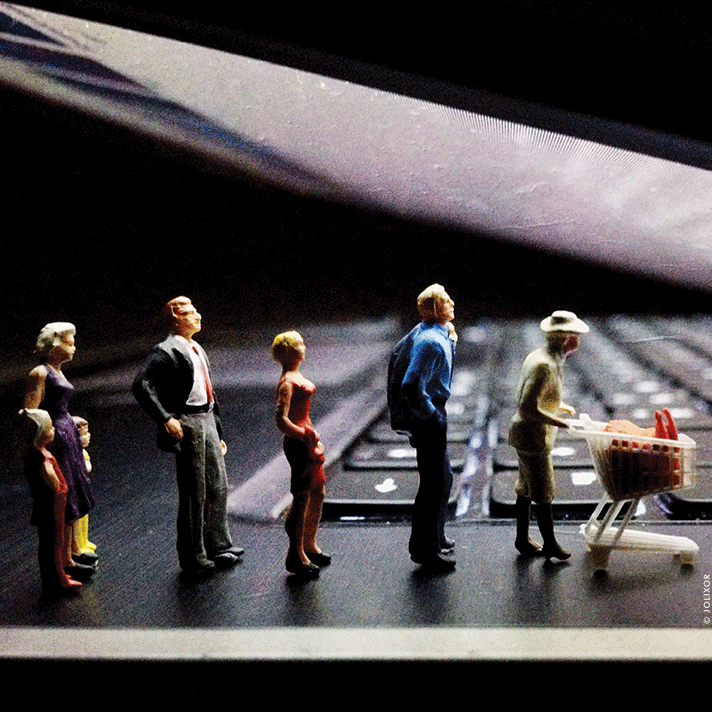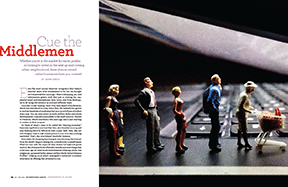
Whether you’re in the market for exotic pickles or looking to invest in the next up-and-coming urban neighborhood, these alumni-owned online businesses have you covered.
BY JOANN GRECO | iPhoneography by Jolixor

Even the most casual observer recognizes that today’s Internet bears little resemblance to the one we thought we’d mastered five years ago. There’s shopping, yes, and information galore, still. But just as texting has supplanted email and smartphones have taken over from desktops, we’re all using the Internet in new and different ways.
Consider crowd funding: most of us have heard of Kickstarter, which was introduced in 2009. Since then, the industry has grown to include hundreds of platforms that now raise billions of dollars every year. You can even invest in multi-million-dollar real estate developments—typically unavailable to the small investor—thanks to Fundrise, which launched a few years ago and is just starting to realize its first projects.
Or think of what’s come to be called the “sharing economy,” famously typified by services like Uber, also founded in 2009 and now booking about $1 billion in rides a year. Well, then, why not rent designer duds to add stylish punch to your everyday working wardrobe? That’s the idea behind Wardrobe Wakeup.
Even plain old shopping has changed, transforming the Internet from the world’s largest catalog into a wondrously curated bazaar filled not only with the expected (like, books) but high-end goods (such as the artisanal foods offered by Mouth) and even things that a few years ago we never would have dreamed of buying online, like eyeglasses—pioneered by the alumni-led firm Warby Parker [“Alumni Profiles,” Jul|Aug 2012], which managed to surmount consumer reluctance by offering free at-home try-ons.
David Bell, the Xinmei Zhang and Yongge Dai Professor at Wharton, studies the company in his Digital Marketing and Electronic Commerce class, and includes it as a case study in his new book Location Is (Still) Everything: The Surprising Influence of the Real World on How We Search, Shop, and Sell in the Virtual One. “Twenty years ago, when Amazon began, the number one catalog category was apparel,” he says. “But Jeff Bezos didn’t go there—he realized that clothing has non-digital attributes that couldn’t be communicated through the Internet. Then Zappos came along and cut the risk, saying, ‘We’ll let you ship the shoes back for free if they don’t work out for you.’ And what Warby Parker did was add on to that: ‘We’ll send you a few free samples and let you ship them back for free when you’re done.’”
The next frontier appears to be same-day delivery, which a lot of companies are working on, says Michael Gluck C’05, founder and president of the tech market-research firm, VG Market. The upshot? We’ve been trained to be comfortable with shopping online as our questions are addressed one by one. Will my credit card number be stolen? Will the stuff show up? Will I have to pay to return it? How long do I have to wait for it? We don’t worry about those things anymore. The field may be crowded, but services that “improve the quality of peoples’ lives at an affordable price will absolutely continue to grow,” Gluck predicts.
There are other ways to stand out besides innovating on the buying experience. For example, rich content (in the form of magazine-like copy, amusing videos, or tip-sheets on how to style clothes or cook food) has always been an asset at Thrillist, which started as a city guide for young men but is now seeking to move from a $100 million effort into the real big leagues by selling products.
Thrillist—like Fundrise, Wardrobe Wakeup, and Mouth—was founded by Penn grads who identified a need and are using the Internet’s low cost of entry, easy but sophisticated technology (such as ever-more elegant blogging software and ever-more complex algorithms), and vast capacity to offer curated, personal experiences to scratch our itches. The sites do the work for us—they find the best food products and the best real estate, note our clothing preferences and send us appropriate choices, identify what’s happening in our city and tell us where we need to be.
A Thrilling Ride

Wharton’s Bell calls those itches “pain points—frustrations that might have existed before, but had no easy mechanism to address them.” Take Adam Rich C’02 and Ben Lerer C’03, who, a few years after graduating, were living in New York. One day, shooting the breeze about their dull jobs, one asked the other to suggest a good date restaurant that was “nice, but not too expensive,” recalls Rich. “We realized that all of the guides out there were very general. They offered the same suggestions for you, for my mom, for me, or whomever.”
The notion compelled them to set up a “city guide for guys like us,” he says. “It was the demographic we knew best: post-college with good jobs and some money and time to spend. We were looking to separate the wheat from the chaff. I thought of the exploring I did while I was at Penn—checking out open mic nights at Ortlieb’s or taking the train and knocking around Kensington—and I wanted to create something with that insider feel.”
Their model was Daily Candy, a then-hot email newsletter aimed at their female counterparts, which served up news about the coolest restaurant openings, the latest products, the best new stores. The duo even reached out to Candy’s funders—and received $250,000 in start-up money. “They made us operate really lean,” Rich says with a laugh. “I remember that, rather than buy a pack of pens, we’d go to the bank and grab them. We had a lot of plastic blue pens.”
Times have changed. Daily Candy is no more. (Comcast bought it in 2008 for a reported $120 million, but NBC/Comcast killed it earlier this year in the face of too much competition and, likely, too little faith.) Meanwhile, Rich and Lerer’s start-up, Thrillist, which launched in 2005, is expected to reach $100 million in annual revenues this year; its 350-plus employees most assuredly do not have to scrounge for ballpoints.
The secret, says Rich, is in commerce. “We started as an online media outlet with free content, and our only revenues were from advertising,” he explains. Within four years, the company was reaping about $8 million in ad sales, but the partners had bigger dreams. “We’ve realized that we’ve been in a really long game to earn people’s trust,” Rich says. “When we wrote about a restaurant, it would see its tables fill up with our readers.” Why not parlay that into something more lucrative by actually selling things to those same readers?
Today, 80 percent of the company’s revenues come from sales, mainly through JackThreads, a fashion site Thrillist acquired four years ago, and Supercompressor, a gadget- and car-centric site it started last year. “The thing we’re working on right now is to make all three brands a blend of content and commerce,” says Rich. “JackThreads can feature an article on how to tie a bow-tie. Or Thrillist can have a recipe for a stovetop steak, and then sell the spatula and the pan.”
And what about that sense of trust? It will be a “delicate balance” to protect the editorial integrity that’s helped build the bond with its 9 million visitors, Rich acknowledges. “But we are looking to further break down that barrier; there’s a shop tab now on all of our sites.”
Another change is the notion of the site as being solely for twenty-something men. Thrillist’s readership base is about 40 percent female, according to Rich. “I like to think about it now as equivalent to addressing a hip, mixed gender group: hey guys, let’s do this! A ‘guy’ is more an attitude of being up for anything, than being a male.” That approach is most evident in “listicles” like “The 12 Things You Must Do In Philly This Fall,” say, or “14 Things You Need To Eat In L.A. This Fall,” which could appeal to anyone. The beer and gear is still there, but there’s less of it.
The content/commerce model wouldn’t have existed in the past, Rich contends. “We were able to self-fund initially with a few thousand dollars, because creating on the Internet is so much cheaper. At the beginning, all we did was send out email newsletters to about 600 people, to every business card we had. It became a very active list and just built from there.” Eventually, investors gained confidence in the effort and Thrillist raised $15 million, including from Lerer Ventures, which was started by Ben’s father, Kenneth, a co-founder of The Huffington Post.
Lerer has gone on the record as saying that the company presents a “quite large” opportunity for an initial public offering and that its goal is to reach a billion dollars in revenue. For now, though, says Rich, it’s more interested in evaluating categories to see if there’s another brand to be launched that blends service-driven content and commerce. “We’d never rule out an IPO, though,” he concludes.
The Mouth That Roared

Craig Kanarick C’89 EAS’89 has already been there, done that. As co-founder of Razorfish in 1995, one of the earliest Internet marketing and design agencies to hit it big, he saw revenues leap from $300,000 to $3 million by 1997. Then, in quick succession, experienced an IPO in 1999, a multi-billion dollar market capitalization in 2000, and, finally, the bursting of the dot-com bubble in 2001. “While we were laying off people, I kept dreaming about the culinary school across the street and how much I’d rather be there,” he says. And so he left.
He didn’t run off to the circus, exactly. But he did spend months working as a prep cook for chef Mario Batali, before joining a restaurant design firm to help with Internet branding initiatives. Kanarick likes to say that he’s been a foodie ever since his mother’s water broke while watching Julia Child on television. As chief executive officer of Mouth—an online store for independently produced food products—he’s managed to merge that interest with the field that first brought him fame and fortune.
Kanarick co-founded the operation with Nancy Kruger Cohen C’89 and their mutual friend, Sam Murray. Mouth represents a departure for all three. Kruger Cohen, the company’s chief creative officer, has a background in magazines and advertising, while Murray, its chief operating officer, ran a manufacturing business for 20 years. The company received an initial $300,000 from investors, confident in Kanarick’s belief that “food has become a common cultural touchstone.” But people want that food to be “healthier, more authentic, with a story behind it,” he adds. “I was surprised that there was all of this interest in indie food and yet there was no real digital component.”
The site began as a showcase for New York-based artisanal foodstuffs because it was the founders’ home turf. Three years on, it’s expanded to include some 700 producers from 40 states who craft everything from crackers to salami. “We currently offer about 70 varieties of pickles,” boasts Kanarick. “We have one of the best, if not the best, pickle stores in the country.”
Mouth’s goal is to introduce food lovers to “products they’ve never heard of,” says Kruger Cohen, who’s responsible for the site’s slick look. “We consider ourselves editors who can establish a personal connection between maker and buyer and ultimately help the makers grow their own businesses,” she continues. Rummaging around Mouth is a delight: it’s chock-full of appealing images, makers’ bios, and filter options that allow searches by food, occasion, maker, or region. Seasonal assemblages are available, too, for about $50-$100. This fall’s “Freshman 15,” for example, featured “old bay bacon peanuts,” “organic hickory-smoked cheddar popcorn,” and 13 other temptations, while its “Apple Picking Taster” included apple-cinnamon marshmallows and apple-caramelized-onion spread.
The packaging of such provisions has taken some practice. “We spent a year making sure that we could execute flawlessly,” Kanarick says. “It’s not easy figuring out how to put a heavy jar of sauce next to a bag of potato chips. We mailed things to ourselves, we dropped cartons at different angles, we mailed to friends in Texas when it was hot and to Minnesota when there was two feet of snow on the ground.” Cheese and chocolate notwithstanding, perishability isn’t a big issue, he says. “We select products that were manufactured to be shipped, and we run a tight warehouse. Having a digital business with a lot of data helps us schedule purchasing and inventory in ways that would otherwise be tough.”
Food catalogs like Harry and David and subscription services like Omaha Steaks have been around for decades, of course, but in selecting independent purveyors as its niche, Mouth hopes to remain distinctive. Its Internet base offers advantages—ease of search, the ability to quickly switch out products and photographs—but they seem almost secondary. In fact, this spring the company opened a bricks-and-mortar location—a not uncommon move for businesses that begin as online-only—that sells small-batch liquor not far from its Brooklyn headquarters.
Revenues—which come via mark-ups—have tripled this year over last. “We see that trajectory only getting better next year,” Kanarick says, “particularly with the expansion of our corporate gifting program and the launch of our Spirits and Wine collection, which are tapping into huge new customer bases.”
A prescient type who set up his first email account while a student at Penn in 1985, Kanarick believes that Mouth is bringing the indie-food craze online at precisely the moment when shopping for groceries over the Internet is gaining traction. “The two trends dovetail exactly into what we’re all about —discovering new and outstanding American-made products and bringing them to people in the most mouth-watering online experience possible.”
Fashionable Fun

Wardrobe Wakeup, a brand new start-up from an alumni husband and wife team, is hoping to tap into the same desire for curated experiences as Mouth, but it’s tossing another Internet trend—the sharing economy—into the mix. Instead of hooking up folks who want to share their cars or apartments, Aaron Fleishman C’11 W’11 and Barbra Dickerman Nu’11 GNu’16 are encouraging fashionable femmes (men may come later) to share designer duds. Only it’s the duo that’s providing the dresses and blouses, not the members. Its motto: thinner closet, thicker wallet.
It’s a variation on the concept made famous by Rent the Runway, a five-year-old effort that’s assembled an astonishing database of 5 million members and an overflowing cache of more than 65,000 dresses, yet only recently hit the $50 million revenue mark. “When we did our beta with friends and family, we were sending out higher-end cocktail dresses and such,” says Fleishman. “But they said they had Rent the Runway for that. What they wanted was classic pieces, things that could enhance their work wardrobes. We were surprised, but that’s the direction we’re going in.”
The initial idea for Wardrobe Wakeup sprang from Dickerman’s own experience. Her champagne tastes were continually at odds with her beer budget, and when she tried to buy fewer, but better quality pieces, “the itch for variety came back,” she says.
Where Rent the Runway charges different amounts for different items and allows members to keep them for either four or eight days, Wardrobe Wakeup is pursuing another pricing model. For $25-$45 per month, members can enjoy a steady diet of one “new” dress or blouse each month. They can keep the item all month and wear it as many times as they like. (The team chose to focus on these two types of garments because they are the easiest to fit and because early market surveys revealed that they are what young women are most interested in.)
Members can also elect to buy the gently used merchandise, at a greatly reduced price. “Currently, we are generating revenue from both the subscription fees and garment purchases,” Fleishman says. “We expect most of it in the long run to derive from subscriptions.” Eventually, the company hopes to secure wholesale privileges from designers, but they haven’t done enough business yet to accomplish that. “We still need to purchase clothing upfront,” Fleishman says, “and only over time do we see a positive return on investment for each piece.”
The key difference, though, is that Rent the Runway is a shopping site—users browse and choose the $1,000 Calvin Klein gown for $70—whereas Wardrobe Wakeup is a curated experience. “People are busy and maybe a little lazy,” says Fleishman. “So there’s a lot of reliability on what big data can do to figure out what a customer will like. We’re a little different, actually. We offer the premium of a personal stylist.” When a prospective member visits the site, she takes a survey that collects everything from her measurements to her color preferences to her “dislikes” (asymmetrical necklines, maxi lengths). “Our users have been most excited by this aspect of the service,” observes Dickerman. “We are seeing strong engagement with our ‘message your stylist’ feature where they can offer more details or request a specific look.”
The business only launched officially last June and, reports Fleishman, “we are growing very quickly now and are trying to keep up.” A vigorous marketing campaign—especially targeting fashion bloggers—has helped. “Their readers trust them and so a good review and unboxing [shared via YouTube and the like] of our product goes a long way. The other big driver has been referrals, for the same reason,” Fleishman says, adding, “we are investing heavily for more growth.”
Real Estate For Everyone

E-commerce sites “level the economic playing field,” says VG Market’s Michael Gluck. “What were once considered exclusive services for rich people are now being made available to anyone with a smartphone.” But retail items like designer duds and gourmet goodies are a far cry from commercial real estate, the luxury product of choice for Fundrise, a Washington-based crowd-funding site started by brothers Daniel Miller W’09 and Benjamin Miller C’99. The site allows investors to ante up as little as $100 for pieces of apartment buildings, hotels, and mixed-use developments, often located in gentrifying neighborhoods.
The brothers grew up around real estate—their father began building his own development business in the nation’s capital four decades ago—and thought there might be a niche for “deals that didn’t fit the folks my father’s firm knew,” says Dan Miller. They started Fundrise on the heels of the passage of the Federal JOBS (Jumpstart Our Business Startups) Act, which eased securities regulations governing crowd-funding. Although not all of the kinks have been worked out, when fully implemented the legislation will bring about a “real shift that will open up what we’re trying to do,” he adds. For now, Fundrise typically invests about 20-30 percent of the total capital for any specific deal—from a pool of $31 million it raised last May during its initial round of funding—with the rest coming from a mix of institutional and smaller investors.
Being Internet-based is critical. “There’s no way we could aggregate thousands of small investors without this technology,” says Miller. As with Mouth, the site acts as a snazzy brochure, instantly available on everyone’s phone, tablet, or desktop, that highlights recent and available projects such as a two-story building in Washington’s Shaw neighborhood that was recently being positioned as ideal for a retail or restaurant tenant. According to the site—which provides images, an overview, and information on the developer and the neighborhood—467 people had committed to invest a total of $1,263,000, easily exceeding the minimum of $300,000 Fundrise has set before it will undertake the laborious process of filing the offering with regulators.
“We’re no longer the real-estate company,” Miller elaborates. “We’re kind of like a merchant banker: we structure the deal.” He contends this quells any questions about whose side—investors or developer—Fundrise is really on.
It’s the Thrillist conundrum all over again, but that’s not the only thing that the two sites have in common. Along with Wardrobe Wakeup, they also share the same impetus: the founders’ realization that a certain frustration might be broadly shared. “Fundrise started with us going into the emerging corridors of DC, where there’s great bones, historic structures, lots of in-fill,” says Miller. “It’s the kind of neighborhood where if you’re out at 3 p.m. on Tuesday, it looks like nothing’s going on, but if it’s 3 a.m. on Saturday, there are people everywhere. It was very apparent to us, but maybe not to a New York developer who’s looking for places to put up shiny glass towers filled with law firms and very little retail.”
Miller says he’s visited “every warehouse district, adjacent to every major downtown,” looking at parcels destined to be boutique hotels, co-working spaces, maker facilities, and the like. “This is where the consumer demand is right now,” he says. “People are interested in more flexible spaces, and while the real estate market is still digesting those changes, we’re ending up being involved in these kinds of leading-edge projects. There’s a perceived risk anytime a market is shifting, but there’s a huge opportunity for those who figure out how to take advantage of it.”
So far, it’s paid off. “We do a lot of due diligence—I’ve probably traveled personally to 40 or 50 cities because it’s important that we have someone on the ground,” says Miller. “Plus, I’ve been impressed by the intelligence of the small investor. They are eager to make informed investments.” Real estate may run in the brothers’ veins, Miller says, but his goal is to get it coursing through many others’. “It’s asset-based, inflation-protected, and tax efficient,” he says. “But it generally takes a lot of bucks. We offer a platform where everyone can invest, regardless of their net worth.”
“We do the hard work, you get the best deals,” the site boasts. The same might be said of the $345 Diane Von Furstenberg dresses available for rent on Wardrobe Wakeup, the $11 peanut-butter tossed in a canvas tote from Mouth, and Thrillist stories like “12 countries you can visit for less than $50 a day.”
JoAnn Greco is a Philadelphia-based freelance writer and regular contributor to the Gazette.

